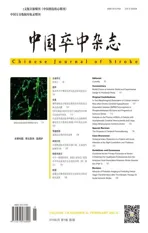脑预适应保护研究进展
2015-01-21赵一龙郭安臣王拥军王群
赵一龙,郭安臣,王拥军,王群
16世纪初,毒理学家Paracelsus观察到“剂量产生毒性”的现象。低于有害剂量的细胞应激能产生一种保护状态,称为“预保护”[1]。1964年,Janoff提出了“预处理”这一概念,即低于损伤阈值的刺激可在随后产生保护作用。在1986年Schurr等[2]表明体外脑组织缺氧可产生低氧适应性。Kitagawa及其同事发现沙鼠短暂的全脑缺血可以保护大脑免受随后长时间缺血造成的损伤[3]。
预适应是这样一种现象:短暂的亚致死损害会为随后发生的致死损伤提供强力的保护作用,它被认为是自然界中的一种常规形式[1]。本文将针对几种常见的大脑预适应保护现象进行综述。到目前为止出现了两种内生机制,即预处理和后处理。预处理对大脑的保护可在刺激后立刻发生(称为早期,快速或经典的预处理),也可延迟1~3 d后发生,以诱导出蛋白合成相关的保护(称为延迟性预处理)[4]。快速预处理在临床中可应用于存在高风险并发症的疾病,如心脏或脑部手术。由于延迟性预处理对大脑的保护作用似乎比早期预处理更强大,因此延迟性预处理在神经内科领域受到越来越多的关注。然而,尽管存在有效的方式来进行大脑的早期预处理,但是对于早期和延迟性预处理所产生的神经保护作用缺少规范的比较。后处理则是一种治疗性的再灌注方式,通过这种方式器官可以得到间歇性灌注,例如在实验中(或在临床中,如血管成形术或器官移植)夹闭动脉的间歇性开启和关闭。后处理是减少局灶性缺血和再灌注损伤的一种新的神经保护方法[5]。
预处理和后处理的效应器是一组相似的下游信号通路,但二者的调控机制可能完全不同,原因在于:后处理开始时诱导快速的神经保护作用,而预处理诱导的神经保护作用则有一个明显的短暂延迟(蛋白质合成依赖性);后处理可能不涉及内源性神经保护的激活,而是在再灌注时减少自由基的释放。下面,我们将分别介绍几种不同的预适应保护形式。
1 缺血预处理
许多体内和体外研究表明,短暂暴露于亚致死性缺血环境中的神经元可产生耐受性,对随后长期且致命的缺血损伤呈现抵抗。这种现象,称为缺血预处理(ischemic preconditioning,IPC)[6]。参与这种现象的分子机制是学者们的研究热点,以便为脑缺血开辟新的治疗途径。
几种不同的预处理刺激包括非损伤性缺血、皮层扩散抑制、短暂癫痫发作、暴露于吸入性麻醉剂中、低剂量的内毒素、高温或热休克都可诱导出对缺血性脑损伤的免疫耐受,从而提供保护作用,防止与刺激形式完全不同的损伤,这一著名现象称为“交叉耐受”现象,即一种刺激可促进对另一种形式的交叉耐受,或者可引起脑耐受性的刺激也可以引起其他器官的耐受性[7]。由于诱导剂和耐受机制可能有类似的特点,因此在一个器官中诱导免疫耐受,可通过神经或旁分泌机制,扩散到其他器官,这种现象被称为“远程预处理”或“远距离预处理”[8]。可诱导保护作用的特定刺激,在强度,时间和(或)频率方面的不同,决定了刺激强度太弱不能引起反应,或刺激强度足够可引起预处理,或刺激强度过大产生损害[9]。
一般情况下,延迟性缺血耐受的诱导需要新蛋白质的合成,并且此耐受的持续时间从几天到几个星期不等。而大脑缺血耐受的时间明显遵从于延迟的模式,可见活性蛋白的合成可能在脑缺血耐受的发展中是必要的[10]。一旦被诱导,缺血耐受会持续几天,并在几星期后逐渐消失。
2 药物预处理
对产生IPC作用的细胞信号通路的识别为我们开创新的治疗策略提供了基本的框架,即用药物模拟预处理的神经保护作用——称为药物预处理[11]。一些内源性药物包括腺苷[12]、一氧化氮[13-14]、硫化氢[15]等已被证明可模拟IPC的细胞保护作用。此外,大电导钙激活钾通道(large-conductance Calcium-activated potassium channels,BKCa)的通道开放剂如NS1619[16],适度的酒精[17],红葡萄酒中的葡萄多酚类化合物白藜芦醇[18-21]以及某些挥发性麻醉药如异氟醚[22-23]等都可以减少梗死面积,且达到类似于IPC后的程度。相对于那些更有危害性并且更加复杂的预处理方式,药物预处理更加容易建立,因此在临床上将其应用于对抗大脑缺血损伤将很有前景。
3 缺血后处理
缺血后处理被定义为在缺血后建立回流时进行简单重复的再灌注,从而可显著改善缺血发作的预后[24]。闭塞血管的再血管化并及时再灌注是目前用于治疗急性缺血性卒中最有效的方法。然而,在再灌注早期阶段会产生活性氧自由基(reactive oxygen species,ROS)及细胞内游离Ca2+超载,从而导致额外的损伤。为了减轻再灌注后的早期充血反应损伤,研究人员提出在缺血后立即进行一系列重复性的短暂中断再灌注的缺血后处理的保护方式[25]。
对损伤性缺血大脑进行不同周期的短暂非损伤性缺血,可实现神经保护作用,并建立了两种研究模型:首先永久性的远端闭塞大脑中动脉,然后再闭塞双侧颈总动脉(common carotid artery,CCA)[26];先进行短暂性大脑中动脉闭塞,然后进行短暂性大脑中动脉闭塞和再灌注[27]。
这种保护机制也在体外(即在海马器官型切片培养和原代神经元的有害的氧糖剥夺模型中)以及非损伤的周期性氧糖剥夺和复氧模型中得到证实[28]。因此,一些治疗方法(即短期缺血,缺氧,异氟醚,去甲肾上腺素和3-硝基丙酸)可以作为后处理的刺激,有效诱导缺血耐受。
4 药物后处理
随着缺血后处理的机制已被阐明,以及药理性缺血后处理的潜在优势,它们中的如腺苷和挥发性麻醉药(如异氟烷),经美国食品药品管理局批准用于改善动物预后方面的研究。这些药理性缺血后处理可能会更适合那些身体太虚弱不能承受微创治疗的患者,或远离专业治疗中心不能得到及时救治的患者。
在兔心肌中应用异氟烷进行缺血后处理或机械性缺血后处理可产生相似的心肌梗死面积的减少[29]。当与机械缺血后处理联合应用时,可产生累积的效果[30]。麻醉药诱导的缺血后处理似乎与机械性缺血后处理存在类似的机制,并且通过抑制再灌注损伤补救激酶途径,可以抵消两者的保护作用[31]。
5 其他预处理
除了上述几种经典的预适应外,还有几种预适应保护类型:低压氧预处理、高压氧预处理、低温预处理、高温预处理、系统性应激预处理。
低压氧预处理是将细胞培养基或动物放置在一个密闭缺氧室中,而密闭缺氧室中为常压缺氧条件(8%的氧气),其余氧气用氮气替换[32]。低压氧预处理模型在体内和体外都能建立,并能有效抑制成人的脑缺血损伤[32]。
高压氧预处理是通过将100%的氧气注入加压舱中实现,可以防止后续的短暂脑缺血损伤。有动物研究表明,相对于短暂快速的高压氧预处理,长期的高压氧预处理更能有效地建立耐受状态[33]。
低温已被建议应用于急诊医学。一次短暂的低温预处理也能产生类似预保护的作用。在大鼠脑切片中,在氧糖剥夺前0~3 h进行低温预处理(33℃,20 min)能有效防止氧糖剥夺导致的浦肯野细胞的死亡[34]。
短暂地暴露于高温中能诱导大脑耐受,减轻缺血性损伤。成年大鼠被放在42℃的水浴装置中15 min,在18 h或24 h后,对其进行大脑中动脉闭塞(middle cerebral artery occlusion,MCAO)结果发现,相较于那些没经过高温预处理的大鼠,经过高温预处理的大鼠的脑梗死面积明显减少,并且学习和记忆能力明显提高[35]。
许多预处理研究是通过急性应激来诱导出神经保护作用。除此之外给予亚致死量的慢性持续性应激如身体锻炼[36]以及节食[37-38]等,也能提供预保护作用。
对脑预适应保护激活的内源性生存机制并不依赖于药代动力学或应用方式的不同,而后两者会阻碍啮齿类动物的神经保护方法转用到人类中。因此,内在的细胞生存通路的识别将提供更直接的机会来转化神经保护试验。虽然目前的研究主要集中在卒中,但是研究者可能会发现,构成脑预适应保护的与生俱来的调节体系同样也适用于保护大脑免受其他急性和慢性神经退行性疾病的影响。
1 Stetler RA, Leak RK, Gan Y, et al. Preconditioning provides neuroprotection in models of CNS disease:paradigms and clinical significance[J]. Prog Neurobiol, 2014, 114:58-83.
2 Schurr A, Reid KH, Tseng MT, et al. Adaptation of adult brain tissue to anoxia and hypoxia in vitro[J].Brain Res, 1986, 374:244-248.
3 Kitagawa K, Matsumoto M, Kuwabara K, et al.'Ischemic tolerance' phenomenon found in the brain[J].Brain Res, 1990, 528:21-24.4
4 Dirnagl U, Becker K, Meisel A. Preconditioning and tolerance against cerebral ischaemia:from experimental strategies to clinical use[J]. Lancet Neurol, 2009, 8:398-412.
5 Zhao H. The protective effect of ischemic postconditioning against ischemic injury:from the heart to the brain[J]. J Neuroimmune Pharmacol, 2007,2:313-318.
6 Gidday JM. Cerebral preconditioning and ischaemic tolerance[J]. Nat Rev Neurosci, 2006, 7:437-448.
7 Pignataro G, Scorziello A, Di Renzo G, et al.Post-ischemic brain damage:effect of ischemic preconditioning and postconditioning and identification of potential candidates for stroke therapy[J]. FEBS J,2009, 276:46-57.
8 Gill R. Remote ischemic preconditioning for myocardial protection:update on mechanisms and clinical relevance[EB/OL]. (2015-01-01)[2015-01-10].http://link.springer.com/article/10.1007%2Fs11010-014-2312-z.
9 Dirnagl U, Simon RP, Hallenbeck JM. Ischemic tolerance and endogenous neuroprotection[J]. Trends Neurosci, 2003, 26:248-254.
10 Barone FC, White RF, Spera PA, et al. Ischemic preconditioning and brain tolerance:temporal histological and functional outcomes, protein synthesis requirement, and interleukin-1 receptor antagonist and early gene expression[J]. Stroke, 1998, 29:1937-1931.
11 Obrenovitch TP. Molecular physiology of preconditioning-induced brain tolerance to ischemia[J].Physiol Rev, 2008, 88:211-247.
12 Williams-Karnesky RL, Stenzel-Poore MP.Adenosine and stroke:maximizing the therapeutic potential of adenosine as a prophylactic and acute neuroprotectant[J]. Curr Neuropharmacol, 2009, 7:217-227.
13 Kunz A, Park L, Abe T, et al. Neurovascular protection by ischemic tolerance:role of nitric oxide and reactive oxygen species[J]. J Neurosci, 2007, 27:7083-7093.
14 Yamaguchi T, Kamada K, Dayton C, et al. Role of eNOS-derived NO in the postischemic antiinflammatory effects of antecedent ethanol ingestion in murine small intestine[J]. Am J Physiol Heart Circ Physiol, 2007, 292:H1435-1442.15.
15 Yusof M, Kamada K, Kalogeris T, et al. Hydrogen sulfide triggers late-phase preconditioning in postischemic small intestine by an NO- and p38 MAPK-dependent mechanism[J]. Am J Physiol Heart Circ Physiol, 2009, 296:H868-876.
16 Gáspár T, Katakam P, Snipes JA, et al. Delayed neuronal preconditioning by NS1619 is independent of calcium activated potassium channels[J]. J Neurochem,2008, 105:1115-1128.
17 Collins MA, Neafsey EJ, Mukamal KJ, et al.Alcohol in moderation, cardioprotection, and neuroprotection:epidemiological considerations and mechanistic studies[J]. Alcohol Clin Exp Res, 2009,33:206-219.
18 Raval AP, Lin HW, Dave KR, et al. Resveratrol and ischemic preconditioning in the brain[J]. Curr Med Chem, 2008, 15:1545-1551.
19 Tan L, Yu JT, Guan HS. Resveratrol exerts pharmacological preconditioning by activating PGC-1 alpha[J]. Med Hypotheses, 2008, 71:664-667.
20 Della-Morte D, Dave KR, Defazio RA, et al.Resveratrol pretreatment protects rat brain from cerebral ischemic damage via a sirtuin 1-uncoupling protein 2 pathway[J]. Neuroscience, 2009, 159:993-1002.
21 Saleh MC, Connell BJ, Saleh TM. Resveratrol preconditioning induces cellular stress proteins and is mediated via NMDA and estrogen receptors[J].Neuroscience, 2010, 166:445-454.
22 Xu X, Kim JA, Zuo Z. Isoflurane preconditioning reduces mouse microglial activation and injury induced by lipopolysaccharide and interferon-gamma[J].Neuroscience, 2008, 154:1002-1008.
23 Li L, Zuo Z. Isoflurane preconditioning improves short-term and long-term neurological outcome after focal brain ischemia in adult rats[J]. Neuroscience,2009, 164:497-506.
24 Gulati P, Singh N. Pharmacological evidence for connection of nitric oxide-mediated pathways in neuroprotective mechanism of ischemic postconditioning in mice[J]. J Pharm Bioallied Sci,2014, 6:233-240.
25 Staat P, Rioufol G, Piot C, et al. Postconditioning the human heart[J]. Circulation, 2005, 112:2143-2148.
26 Zhao H, Sapolsky RM, Steinberg GK. Interrupting reperfusion as a stroke therapy:ischemic postconditioning reduces infarct size after focal ischemia in rats[J]. J Cereb Blood Flow Metab, 2006,26:1114-1121.
27 Pignataro G, Meller R, Inoue K, et al. In vivo and in vitro characterization of a novel neuroprotective strategy for stroke:ischemic postconditioning[J]. J Cereb Blood Flow Metab, 2008, 28:232-241.
28 Scartabelli T, Gerace E, Landucci E, et al.Neuroprotection by group I mGlu receptors in a rat hippocampal slice model of cerebral ischemia is associated with the PI3K-Akt signaling pathway:a novel postconditioning strategy?[J]. Neuropharmacology,2008, 55:509-516.
29 Wang C, Neff DA, Krolikowski JG, et al. The influence of B-cell lymphoma 2 protein, an antiapoptotic regulator of mitochondrial permeability transition, on isoflurane-induced and ischemic postconditioning in rabbits[J]. Anesth Analg, 2006, 102:1355-1360.
30 Obal D, Dettwiler S, Favoccia C, et al. The influence of mitochondrial KATP-channels in the cardioprotection of preconditioning and postconditioning by sevoflurane in the rat in vivo[J]. Anesth Analg, 2005, 101:1252-1260.
31 Chiari PC, Bienengraeber MW, Pagel PS, et al.Isoflurane protects against myocardial infarction during early reperfusion by activation of phosphatidylinositol-3-kinase signal transduction:evidence for anestheticinduced postconditioning in rabbits[J]. Anesthesiology,2005, 102:102-109.
32 Fan YY, Hu WW, Dai HB, et al. Activation of the central histaminergic system is involved in hypoxiainduced stroke tolerance in adult mice[J]. J Cereb Blood Flow Metab, 2011, 31:305-314.
33 Soejima Y, Ostrowski RP, Manaenko A, et al. Hyperbaric oxygen preconditioning attenuates hyperglycemia enhanced hemorrhagic transformation after transient MCAO in rats[J]. Med Gas Res, 2012, 2:9.
34 Yuan HB, Huang Y, Zheng S, et al. Hypothermic preconditioning reduces Purkinje cell death possibly by preventing the over-expression of inducible nitric oxide synthase in rat cerebellar slices after an in vitro simulated ischemia[J]. Neuroscience, 2006, 142:381-389.35
35 Su Z, Han D, Sun B, et al. Heat stress preconditioning improves cognitive outcome after diffuse axonal injury in rats[J]. J Neurotrauma, 2009, 26:1695-1706.
36 Zigmond MJ, Cameron JL, Hoffer BJ, et al.Neurorestoration by physical exercise:moving forward[J]. Parkinsonism Relat Disord, 2012, 18:S147-150.
37 Cerqueira FM, Cunha FM, Laurindo FR, et al. Calorie restriction increases cerebral mitochondrial respiratory capacity in a NO*-mediated mechanism:impact on neuronal survival[J]. Free Radic Biol Med, 2012,52:1236-1241.
38 Pepping JK, Freeman LR, Gupta S, et al. NOX2 deficiency attenuates markers of adiposopathy and brain injury induced by high-fat diet[J]. Am J Physiol Endocrinol Metab, 2013, 304:E392-E404.
【点睛】
大脑预适应保护是一种新兴的脑保护策略,本文对几种常见的大脑预适应保护现象展开详细介绍。
